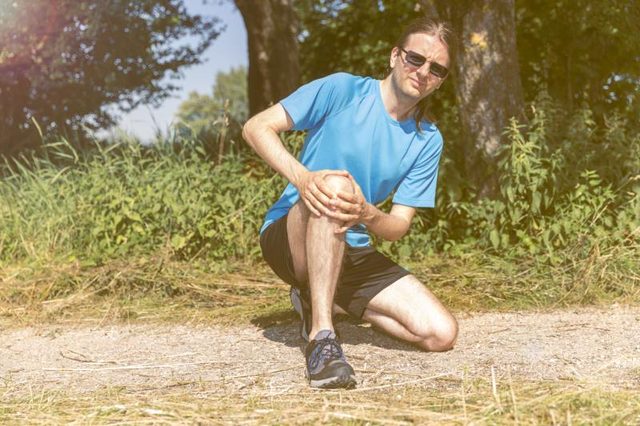Knee Pain While Walking

Walking is a good form of exercise. When done briskly enough, it can help to burn calories and shed extra pounds, which is important because carrying extra weight can cause knee pain. It is also a form of weight bearing exercise, which helps to keep the bones strong. This is especially critical for those with or at risk for osteoporosis. Living with knee pain can make walking challenging. However, there are some exercises and techniques that can be tried that may help.
Considerations
First, it is important to have the cause of any knee pain properly diagnosed and get a doctor's OK to walk. Knee pain that is caused by ligament or tendon tears may require surgery before becoming active. In addition, there are various forms of arthritis that can cause knee pain and they all require a different treatment approach. Inflammatory types such as rheumatoid arthritis, may necessitate rest during a flare up, while with other kinds of arthritis such as osteoarthritis, it may be okay to continue to walk even when the joint hurts.
Once the cause of the knee pain is diagnosed and the extent of any injury or disease is known, a physician or physical therapist can advise on the safety of participating in a walking program. A therapist can also advise when it may be helpful to use a knee brace or cane to make walking more tolerable.
Strength Training
Walking has many positive health benefits, however if knee pain limits waking there are exercises that can be done to help. First, it is important to incorporate strength training exercises into the routine. Strong legs help the knee joint absorb shock which can reduce pain, states the American Academy of Orthopaedic Surgeons.
Exercises such as squats, lunges and standing leg lifts can help to build up the muscles in the legs. There are also many exercises which can be done with ankle weights, tubing and machines. Strength training exercises should be done two to three times a week, with a day of rest in-between. As the muscles get stronger, there is less stress placed on the knee joint which can make walking more comfortable. If new to exercise, work with a therapist or trainer to lean how to exercise correctly without hurting the knees.
Stretching
Just as weak muscles can contribute to knee pain, so can muscles that are tight. When there is reduced flexibility in the muscles the knee joint is restricted during movements, such as reaching the leg out to take a step. According to the Mayo Clinic, weak and tight muscles are the leading cause of knee pain because they both place excessive force on the knee joint during movement.
To help control knee pain, it is important to adopt a daily gentle stretching program for the legs. Stretching should be done slowly and each stretch should be held for at least 30 seconds without bouncing. Stretches are best done when the body is warm, such as after a walk. A trainer or physical therapist can teach the best stretches to do, based on the cause of the knee pain.
Water Walking
Sometimes even with the above techniques, knee pain can still make walking too challenging. In these cases it may be best to start with water walking. The water takes the weight off of the joints and helps the muscles to relax, so walking is less painful. However it still helps to condition the body. The Arthritis Today Magazine claims that, “Water provides 12 times the resistance of air, so as you walk, you’re really strengthening and building muscle.” Walking can be done in the shallow end of the pool, or in the deep end while wearing a flotation devise. The Arthritis Foundation offers specialized classes in water exercise, which can be a good way to start.
Solution
Even though knee pain can make walking challenging, it is important to stay active and motivated. To help, the Arthritis Foundation suggests allowing flexibility into the overall routine. This means dropping the all or nothing approach. On days when the pain is worse, modify the routine and on days when the knee feels better, do more. This makes it easier to stick with a routine and stay on track, rather than skipping exercise all together when symptoms flare. Keep in mind all of the positive benefits of exercise and remember what the body feels like when exercise is discontinued. Lastly, find ways to manage the stress or anxiety over knee pain. Try taking deep breaths before exercising to help calm the body and mind and mentally prepare for the walk.
Note – This information has been taken from different internet sources.
- Choosing a selection results in a full page refresh.
